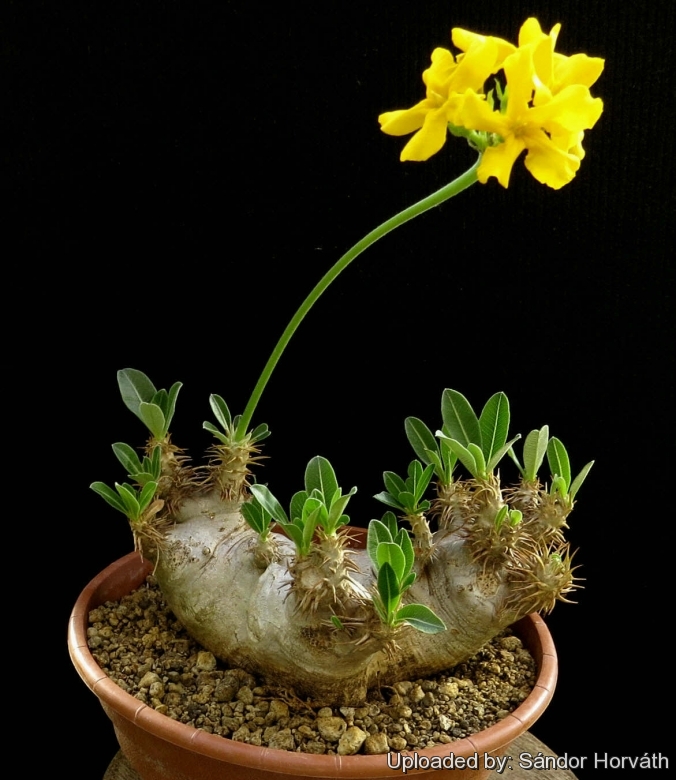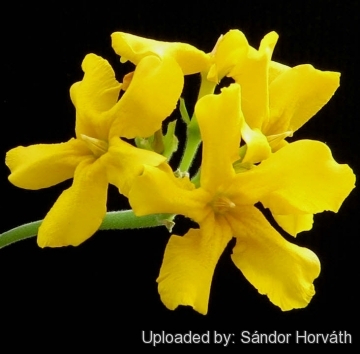= Pachypodium densiflorum var. brevicalyx H.Perrier
Bull. Soc. Bot. France 81: 303 (1934)
Accepted Scientific Name: Pachypodium densiflorum Baker
J. Linn. Soc., Bot. 22: 503 (1887)

Pachypodium brevicalyx (Pachypodium densiflorum var. brevicalyx) Photo by: Sándor Horváth
Origin and Habitat: Pachypodium densiflorumSN|14808]]SN|14808]] var. brevicalyx comes from a separate area, slightly north west of the south-central locus of var. densiflorum on sandstone at an altitude of about 200 metres.
Synonyms:
See all synonyms of Pachypodium densiflorum
Description: Pachypodium densiflorumSN|14808]]SN|14808]] var. brevicalyx is a local or morphological form of Pachypodium densiflorumSN|14808]]SN|14808]] distinguished by having the leaf blade tapered below into a short petiole, a shortly pubescent inflorescence, shorter half-size sepals (the green outer whorl of flower parts) only (1-)3(-7) mm long, slightly smaller flowers borne on longer pedicels (7-)15-24(-25) mm long, and hairs inside the somewhat deeper corolla tube. However the length of sepals in the standard Pachypodium densiflorumSN|14808]]SN|14808]] is quite variable (from 3 to 9.5 mm), showing a continous variation in sepal length. Therefore the sepal characters of the var. brevicalyx appear to fall within the natural variation Pachypodium densiflorumSN|14808]]SN|14808]] and it should be synonymized with the latter.
Taxonomic history: Pachypodium densiflorumSN|14808]]SN|14808]] var. brevicalyx was described as a variety of Pachypodium densiflorumSN|14808]]SN|14808]] by Perrier in 1934, but raised to specific status by Pichon in 1949. Rauh (1963) discussed its position in an article on P. densiflorum and came to the conclusion that it was merely a local variety of P. densiflorum. Markgraf (1976) treated it as a variety.
Derivation of varietal name: The varietal epithet 'brevicalyx' comes frorm Latin 'brevis' (= short); and Latin 'calyx' (= calyx) and means "with a short calyx".
Subspecies, varieties, forms and cultivars of plants belonging to the Pachypodium densiflorum group
Bibliography: Major references and further lectures
1) Urs Eggli "Illustrated Handbook of Succulent Plants: Monocotyledons" Springer Science & Business Media, 06 December 2012
2) Urs Eggli, Leonard E. Newton "Etymological Dictionary of Succulent Plant Names" Springer Science & Business Media, 29 June 2013
3) Gordon D. Rowley “Pachypodium and Adenium” Cactus File, Cirio Pub. Services, 1999
4) Werner Rauh “Succulent and xerophytic plants of Madagascar”, Volume 1 Strawberry Press, 1995
5) S. H. J. V. Rapanarivo “Pachypodium (Apocynaceae)” CRC Press, 01 June 1999
6) “The Flowering Plants of Africa”, Volumes 50-51 Botanical Research Institute, Department of Agricultural Technical Services, Republic of South Africa., 1988
7) Friedrich Markgraf in "Fl. Madag." fam. 169: 299 (1976).
 Pachypodium brevicalyx (Pachypodium densiflorum var. brevicalyx) Photo by: Sándor Horváth
Pachypodium brevicalyx (Pachypodium densiflorum var. brevicalyx) Photo by: Sándor HorváthSend a photo of this plant.The gallery now contains thousands of pictures, however it is possible to do even more. We are, of course, seeking photos of species not yet shown in the gallery but not only that, we are also looking for better pictures than those already present.
Read More... Cultivation and Propagation: Pachypodium densiflorumSN|14808]]SN|14808]] var. brevicalyx is one of the most attractive species in the entire genus that can be grown both indoors, as well as outdoors in warm climates. It’s a moderate grower and an impressive caudex can be steadily developed. In the winters it is deciduous, except in very tropical areas.
Frost resistance: It is tender and should not be exposed to frost (USDA Hardiness zones: 10 – 11).
Soil: Needs a draining cactus potting mix
Water: It requires regular water when the plant has leaves, contrary to popular belief, it likes a lot of water in the warm summers, as long as it's planted in a very well draining soil and considerably less water in the cool months. Indoors it is best to keep it on the dry side, or it is prone to rot. Do not let this specimen sit damp in cool weather.
exposition: It like full sun to light shade.
Maintenance: This Pachypodium will not require any pruning to look like a very interesting and unusual bonsai, but after several years it can outgrow its indoor location, requiring a 'pruning'. It has amazing regenerative properties.
Repot: Repot the plant every 3 years; this is quite tricky given all the spines. The best way is to wrap several layers of newspaper around the trunk where it is to be handled.
Warning: This plant has spines use caution when handling.
Propagation: Seeds or (rarely) cuttings. Fresh seeds results in a remarkable yield of new plants, perhaps 90% and seedlings grow fairly easily. Soak seeds in warm water for 24 hours before sowing in a 5 mm deep, sterile, moist sandy medium (4 parts fine and 4 parts coarse river sand 1 part sieved, well-rotten compost; 1 part perlite; 1 part vermiculite. Keep the mix moist and at a temperature of 27–35°C to ensure rapid germination. Seed start sprouting in just 3-4 days ( but continue to germinate erratically for about 6 month) they are also propagated by removal of branches from old plant (if they need to be pruned). They should be allowed to dry for 5 to 8 days before potting up, however the cuttings often fail to root.












